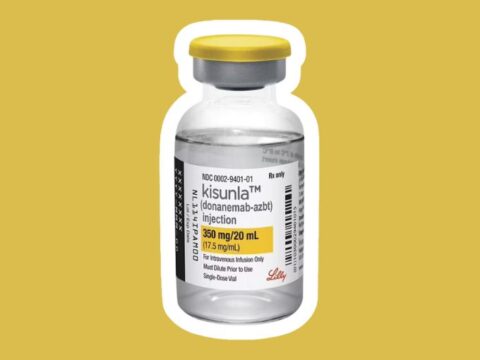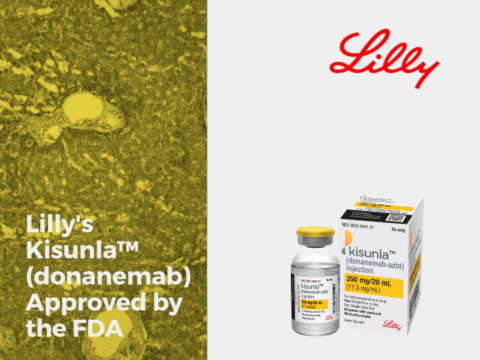
Eli Lilly and Company (NYSE: LLY) announced today positive results of the TRAILBLAZER-ALZ 2 Phase 3 study showing that donanemab significantly slowed cognitive and functional decline in people with early symptomatic Alzheimer’s disease. Donanemab met the primary endpoint of change from baseline until 18 months on the integrated Alzheimer’s Disease Rating Scale (iADRS). The primary endpoint of iADRS measures cognition and activities of daily living such as managing finances, driving, engaging in hobbies, and conversing about current events. All secondary endpoints of cognitive and functional decline were also met and showed highly statistically significant clinical benefits with similar magnitude. Based on these results, Lilly will proceed with global regulatory submissions as quickly as possible and anticipates making a submission to the U.S. Food and Drug Administration (FDA) yet this quarter. Lilly will work with the FDA and other global regulators to achieve the fastest path to traditional approvals.
TRAILBLAZER-ALZ 2, a randomized, double-blind, placebo-controlled study, evaluated the safety and efficacy of donanemab, an investigational amyloid plaque targeting therapy. The study enrolled people with early symptomatic Alzheimer’s disease (AD), which includes mild cognitive impairment (MCI) and the mild dementia stage of disease, with the confirmed presence of AD neuropathology, and participants completed their course of treatment with donanemab once they reached a prespecified level of amyloid plaque clearance.
Nearly half (47%) of the participants on donanemab (compared to 29% on placebo) had no clinical progression at 1 year (defined as no decline in CDR-SB)
Phase 3 trial met primary endpoint and all secondary endpoints measuring cognitive and functional decline
Donanemab treatment slowed clinical decline by 35% compared to placebo, and resulted in 40% less decline on the ability to perform activities of daily living
Over half of all participants completed their course of treatment by 12 months
Participants in TRAILBLAZER-ALZ 2 were stratified by their level of the brain protein tau, a predictive biomarker for Alzheimer’s disease progression. The primary analysis population (n=1182) for which the study was powered was comprised of people with an intermediate level of tau and clinical symptoms of Alzheimer’s disease. In this population, the primary endpoint (iADRS) showed 35% slowing of decline (p<0.0001), and an important key secondary endpoint (Clinical Dementia Rating-Sum of Boxes, or CDR-SB) showed 36% slowing of decline (p<0.0001) over 18 months. Additional prespecified secondary analyses showed:
- 47% of participants on donanemab showed no decline on CDR-SB, a key measure of disease severity at 1 year (compared to 29% of participants on placebo, p<0.001).
- 52% of participants completed their course of treatment by 1 year and 72% completed by 18 months as a result of achieving plaque clearance.
- Participants on donanemab had 40% less decline in ability to perform activities of daily living at 18 months [as measured by Alzheimer’s Disease Cooperative Study – instrumental Activities of Daily Living Inventory (ADCS-iADL), p<0.0001].
- Participants on donanemab experienced a 39% lower risk of progressing to the next stage of disease compared to placebo (CDR-Global Score, HR=0.61; p<0.001).
“Over the last 20 years, Lilly scientists have blazed new trails in the fight against Alzheimer’s disease by elucidating basic mechanisms of AD pathology and discovering imaging and blood biomarker tools to track the pathology,” said Daniel Skovronsky, M.D., Ph.D., Lilly’s chief scientific and medical officer, and president of Lilly Research Laboratories. “We are extremely pleased that donanemab yielded positive clinical results with compelling statistical significance for people with Alzheimer’s disease in this trial. This is the first Phase 3 trial of any investigational medicine for Alzheimer’s disease to deliver 35% slowing of clinical and functional decline.”
The study also enrolled a smaller number of people with high levels of tau at baseline (n=552), representing a later stage of disease progression. Because these participants were predicted to progress more quickly and be less responsive to therapy, the target population for the study was the intermediate tau population. The high tau participants were combined with the intermediate tau population in an additional primary analysis of all participants enrolled (n=1736). In this combined population, donanemab also demonstrated meaningful positive results across all clinical endpoints (p<0.001), with CDR-SB and iADRS showing 29% and 22% slowing of decline, respectively.
Dr Richard Oakley, Associate Director of Research at Alzheimer’s Society, said: “After 20 years with no new Alzheimer’s drugs, we now have two potential new drugs in just twelve months – and for the first time, drugs that seem to slow the progression of disease. This could be the beginning of the end of Alzheimer’s disease.
The incidence of amyloid-related imaging abnormalities (ARIA) was consistent with the TRAILBLAZER-ALZ Phase 2 study. ARIA is observed with the amyloid plaque clearing antibody class of therapies and is most commonly observed as temporary swelling in an area or areas of the brain (ARIA-E) or as microhemorrhages or superficial siderosis (ARIA-H), in either case detected by MRI. In the overall donanemab treatment group, ARIA-E occurred in 24.0% of treated participants, with 6.1% experiencing symptomatic ARIA-E. ARIA-H occurred in 31.4% in the donanemab group and 13.6% in the placebo group. The majority of ARIA cases were mild to moderate and resolved or stabilized with appropriate management. ARIA is usually asymptomatic, although serious and life-threatening events can occur. In this study, the incidence of serious ARIA was 1.6%, including two participants whose death was attributed to ARIA and a third participant who died after an incident of serious ARIA. Infusion-related reactions occurred in 8.7% of participants with most cases mild to moderate in severity.
“We are encouraged by the potential clinical benefits that donanemab may provide, although like many effective treatments for debilitating and fatal diseases, there are associated risks that may be serious and life-threatening,” said Mark Mintun, M.D., group vice president Neuroscience Research & Development at Lilly, and president of Avid Radiopharmaceuticals. “We note that these results suggest that people in the early pathological stage of disease could be the most responsive to therapeutics targeting amyloid. We thank the participants in the clinical trial and their loved ones for their time and commitment to finding solutions for this disease.”
In addition to slowing cognitive and functional decline in TRAILBLAZER-ALZ 2, donanemab produced significant reductions in brain amyloid plaque levels as early as 6 months after initiating treatment, as observed using amyloid positron emission tomography (PET) brain scan, with many patients reaching amyloid levels considered negative for pathology1 (34% of participants in the intermediate tau population achieved amyloid clearance at 6 months and 71% achieved clearance at 12 months).
“Amyloid plaque is a defining pathophysiological feature of Alzheimer’s disease,” said Dr. Eric Reiman, CEO of Banner Research, one of the research sites for the TRAILBLAZER-ALZ 2 trial. “This study’s topline results provide compelling support for the relationship between amyloid plaque removal and a clinical benefit in people with this disease.”
“These Phase 3 data confirm the benefit observed in our TRAILBLAZER-ALZ study and show that donanemab, if approved, may represent a significant step forward for people with early symptomatic Alzheimer’s disease, and allow them to continue to participate in activities that are meaningful to them,” said Anne White, executive vice president of Eli Lilly and Company and president of Lilly Neuroscience. “We believe our data meets the ‘high level of evidence’ the Centers for Medicare & Medicaid Services (CMS) has described as the trigger for reconsideration of its National Coverage Determination. People with early Alzheimer’s disease need and deserve full coverage and access for approved therapies.”
Topline study results:
In the intermediate tau population, the baseline characteristics were similar to other contemporary early symptomatic AD studies (e.g., MMSE score was 22.9). Accordingly, the placebo arm progressed as expected (decline on iADRS and CDR-SB of 9.3 and 1.9 points respectively over 18 months). Prespecified analyses used standard statistical methods including the mixed model for repeated measures (MMRM) and natural cubic spline (NCS) analyses, with similar results across both methods. The following efficacy measures were obtained at 18 months comparing decline in donanemab to placebo treated participants:
|
Intermediate tau |
MMRM statistical analysis |
NCS statistical analysis |
||
|
Relative % slowing |
p-value |
Relative % slowing |
p-value |
|
|
iADRS |
40 % |
p<0.0000004 |
35 % |
p<0.000004* |
|
CDR-SB |
36 % |
p<0.000002* |
37 % |
p<0.0000005 |
|
ADCS-iADL |
43 % |
p<0.00005 |
40 % |
p<0.0001* |
|
ADAS-Cog13 |
35 % |
p<0.00003 |
32 % |
p<0.00005* |
|
*indicates alpha-controlled analyses; iADRS= Alzheimer’s Disease Rating Scale; CDR-SB= Clinical Dementia Rating-Sum of Boxes; ADCS-iADL = Alzheimer’s Disease Cooperative Study – instrumental Activities of Daily Living Inventory (iADL); ADAS-Cog13 = the 13-item Alzheimer’s Disease Assessment Scale – Cognitive |
In the combined intermediate and high tau population the baseline MMSE score was 22.3 and the placebo arm showed a greater decline compared to the intermediate tau population (worsening on iADRS and CDR-SB of 13.1 and 2.4 points respectively over 18 months). Study results at 18 months showed:
|
Combined intermediate |
MMRM statistical analysis |
NCS statistical analysis |
||
|
Relative % slowing |
p-value |
Relative % slowing |
p-value |
|
|
iADRS |
23 % |
p<0.00004 |
22 % |
p<0.00006* |
|
CDR-SB |
29 % |
p<0.00000005* |
29 % |
p<0.00000007 |
|
ADCS-iADL |
28 % |
p<0.0002 |
28 % |
p<0.0002* |
|
ADAS-Cog13 |
19 % |
p<0.0008 |
20 % |
p<0.0007* |
|
*indicates alpha-controlled analyses |
Full results of the TRAILBLAZER-ALZ 2 study will be presented at the Alzheimer’s Association International Conference in July and submitted for publication in a peer-reviewed clinical journal.
About TRAILBLAZER-ALZ 2 Study and the TRAILBLAZER-ALZ program
TRAILBLAZER-ALZ 2 (NCT04437511) is a Phase 3, double-blind, placebo-controlled study to evaluate the safety and efficacy of donanemab in participants ages 60-85 years with early symptomatic Alzheimer’s disease (MCI or mild dementia due to Alzheimer’s disease) with the presence of confirmed Alzheimer’s disease neuropathology. The trial enrolled 1736 participants selected based on cognitive assessments in conjunction with amyloid plaque imaging and tau staging by PET imaging.
Lilly previously announced and published in the New England Journal of Medicine (NEJM) results from the Phase 2 TRAILBLAZER-ALZ study in 2021. In addition, Lilly shared data from TRAILBLAZER-ALZ 4, the first active comparator study in early symptomatic Alzheimer’s disease, at the 15th Clinical Trials on Alzheimer’s Disease (CTAD) conference in 2022.
Lilly continues to study donanemab in multiple clinical trials, including TRAILBLAZER-ALZ 3, which is focused on preventing symptomatic Alzheimer’s disease in participants with preclinical AD; TRAILBLAZER-ALZ 5, a registration trial for early symptomatic Alzheimer’s disease currently enrolling in China; and TRAILBLAZER-ALZ 6, which is focused on expanding our understanding of ARIA through novel MRI sequences, blood-based biomarkers and different dosing regimens of donanemab.
About Lilly
Lilly unites caring with discovery to create medicines that make life better for people around the world. We’ve been pioneering life-changing discoveries for nearly 150 years, and today our medicines help more than 51 million people across the globe. Harnessing the power of biotechnology, chemistry and genetic medicine, our scientists are urgently advancing new discoveries to solve some of the world’s most significant health challenges, redefining diabetes care, treating obesity and curtailing its most devastating long-term effects, advancing the fight against Alzheimer’s disease, providing solutions to some of the most debilitating immune system disorders, and transforming the most difficult-to-treat cancers into manageable diseases. With each step toward a healthier world, we’re motivated by one thing: making life better for millions more people. That includes delivering innovative clinical trials that reflect the diversity of our world and working to ensure our medicines are accessible and affordable. To learn more, visit Lilly.com and Lilly.com/newsroom or follow us on Facebook, Instagram, Twitter and LinkedIn. P-LLY
© Lilly USA, LLC 2023. ALL RIGHTS RESERVED.
Cautionary Statement Regarding Forward-Looking Statements
This press release contains forward-looking statements (as that term is defined in the Private Securities Litigation Reform Act of 1995) about donanemab as a potential treatment for people with early symptomatic Alzheimer’s disease and the timeline for future readouts, presentations, and other milestones relating to donanemab and its clinical trials and reflects Lilly’s current beliefs and expectations. However, as with any pharmaceutical product, there are substantial risks and uncertainties in the process of drug research, development, and commercialization. Among other things, there is no guarantee that that planned or ongoing studies will be completed as planned, that future study results will be consistent with study findings to date, that donanemab will prove to be a safe and effective treatment, or that donanemab will receive regulatory approval. For further discussion of these and other risks and uncertainties, see Lilly’s Form 10-K and Form 10-Q filings with the United States Securities and Exchange Commission. Except as required by law, Lilly undertakes no duty to update forward-looking statements to reflect events after the date of this release.
1. JAMA. 2011;305(3):275-283
|
Refer to: |
J.K. Wall; jkwall@lilly.com; 317-433-5328 (Media) |
|
Joe Fletcher; jfletcher@lilly.com; 317-296-2884 (Investors) |
SOURCE Eli Lilly and Company

 Print This Post
Print This Post





